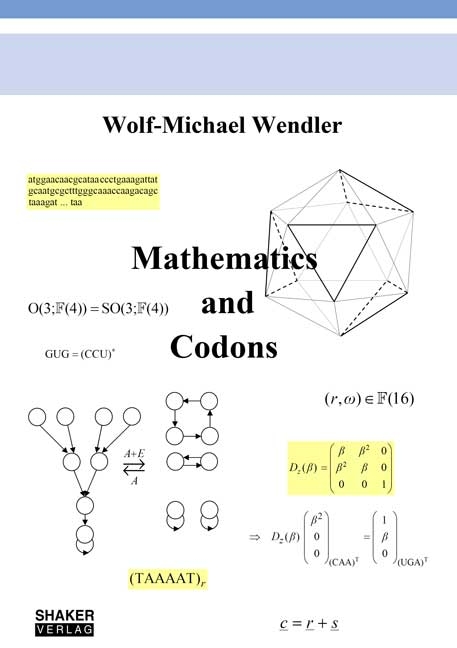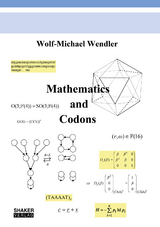Zu diesem Artikel existiert eine Nachauflage
The book consists of eight Chapters,
Elementary Number Theory, Algebra, and Linear Algebra
Representations of Codons and the Protein Code
Differential Geometry of Space Curves and Supplements to Groups
Elementary Protein Structure and (r, ω)-pairs
Elementary Protein Structure and Affine Geometry
Comparison of Approaches, similar Codes, Mutations, and Redundancy
Linear Systems Theory
Repetition Codes and Nonlinear Systems.
The first Chapter contains basic mathematics needed for the rest of the book, i.e. groups, rings and in particular finite fields, as well as linear algebra. This may serve as an introduction to those readers not acquainted with these mathematical topics.
Within Chapter 2, some introductory remarks on Codons and the protein code are given, while in Section 2 the definition, representation, and geometric aspects of Codons are presented. Thereby, 3-Codons are defined as three-dimensional vectors over the field 𝔽(4). Section 3 consists of the assignment to amino acids that rely on the definition of Codon multiplets. By number theoretical and information theoretical methods, these numbers are derived.
Chapter 3 gives the mathematical basics relevant for Chapter 4, that are space curves in the sense of differential geometry and motions. For the latter we recover the icosahedron group over the field 𝔽(4) and discuss the helix vector. Finally some supplements to groups are given.
Elementary protein structure and (r, ω)-pairs is the content of Chapter 4. While primary structure is shortly, emphasis is put on secondary structure. For two proteins, namely the croand cii-protein of the enterobacteria lambda we calculate the localization of the secondary structures. In addition, we treat part of the tertiary structure by assigning axes to secondary structures, which is thoroughly worked out in Chapter 5.
In Chapter 5 we present an additional approach to elementary protein structure based on affine geometry. While primary structure is governed by the eigenvalues of the Codon matrix, secondary structure is dominated by fixed points of the Codon matrix. Tertiary structure relies on secondary structure in so far as we define axes representing secondary structures.
Chapter 6 gives first a comparison of both approaches. We then turn to similar protein Codes and treat mutations, where we restrict us predominantly to point mutations. Finally, we discuss redundancy, which partly is prepared within the frame of mutations and in Chapter 5.
Linear systems theory is treated in the seventh Chapter. It is shown, that there exist phenomena like the nonlocal behaviour of the solutions, period doubling, and self-replication obtained by employing linear equations over finite fields, which usually show up in conjunction with nonlinear equations over the field of real numbers, only.
The last Chapter treats repetition codes as well as nonlinear systems over finite fields. Repetition Codes show up also in Chapters 5, 6, and 7.
Elementary Number Theory, Algebra, and Linear Algebra
Representations of Codons and the Protein Code
Differential Geometry of Space Curves and Supplements to Groups
Elementary Protein Structure and (r, ω)-pairs
Elementary Protein Structure and Affine Geometry
Comparison of Approaches, similar Codes, Mutations, and Redundancy
Linear Systems Theory
Repetition Codes and Nonlinear Systems.
The first Chapter contains basic mathematics needed for the rest of the book, i.e. groups, rings and in particular finite fields, as well as linear algebra. This may serve as an introduction to those readers not acquainted with these mathematical topics.
Within Chapter 2, some introductory remarks on Codons and the protein code are given, while in Section 2 the definition, representation, and geometric aspects of Codons are presented. Thereby, 3-Codons are defined as three-dimensional vectors over the field 𝔽(4). Section 3 consists of the assignment to amino acids that rely on the definition of Codon multiplets. By number theoretical and information theoretical methods, these numbers are derived.
Chapter 3 gives the mathematical basics relevant for Chapter 4, that are space curves in the sense of differential geometry and motions. For the latter we recover the icosahedron group over the field 𝔽(4) and discuss the helix vector. Finally some supplements to groups are given.
Elementary protein structure and (r, ω)-pairs is the content of Chapter 4. While primary structure is shortly, emphasis is put on secondary structure. For two proteins, namely the croand cii-protein of the enterobacteria lambda we calculate the localization of the secondary structures. In addition, we treat part of the tertiary structure by assigning axes to secondary structures, which is thoroughly worked out in Chapter 5.
In Chapter 5 we present an additional approach to elementary protein structure based on affine geometry. While primary structure is governed by the eigenvalues of the Codon matrix, secondary structure is dominated by fixed points of the Codon matrix. Tertiary structure relies on secondary structure in so far as we define axes representing secondary structures.
Chapter 6 gives first a comparison of both approaches. We then turn to similar protein Codes and treat mutations, where we restrict us predominantly to point mutations. Finally, we discuss redundancy, which partly is prepared within the frame of mutations and in Chapter 5.
Linear systems theory is treated in the seventh Chapter. It is shown, that there exist phenomena like the nonlocal behaviour of the solutions, period doubling, and self-replication obtained by employing linear equations over finite fields, which usually show up in conjunction with nonlinear equations over the field of real numbers, only.
The last Chapter treats repetition codes as well as nonlinear systems over finite fields. Repetition Codes show up also in Chapters 5, 6, and 7.
| Erscheinungsdatum | 17.03.2021 |
|---|---|
| Reihe/Serie | Berichte aus der Mathematik |
| Verlagsort | Düren |
| Sprache | englisch |
| Maße | 240 x 170 mm |
| Gewicht | 1116 g |
| Themenwelt | Mathematik / Informatik ► Mathematik |
| Schlagworte | finite fieldsm • linear systems theory • Non-linear Systems • Protein Structure • Repezizion Codes |
| ISBN-13 | 9783844078589 / 9783844078589 |
| Zustand | Neuware |
| Informationen gemäß Produktsicherheitsverordnung (GPSR) | |
| Haben Sie eine Frage zum Produkt? |
Mehr entdecken
aus dem Bereich
aus dem Bereich
Von Logik und Mengenlehre bis Zahlen, Algebra, Graphen und …
Buch | Softcover (2024)
De Gruyter Oldenbourg (Verlag)
CHF 104,90
Grundlagen für das Bachelor-Studium
Buch | Hardcover (2023)
Hanser (Verlag)
CHF 55,95





